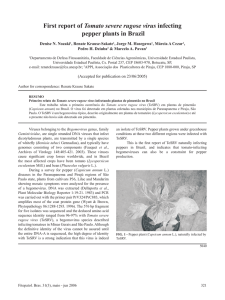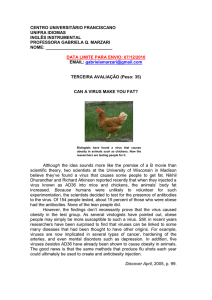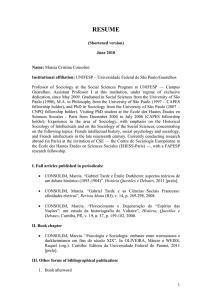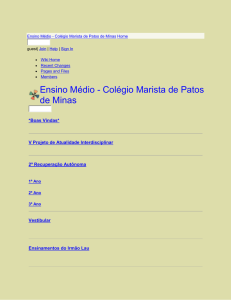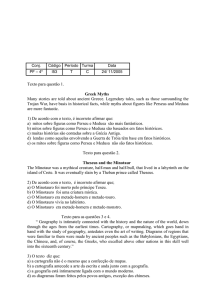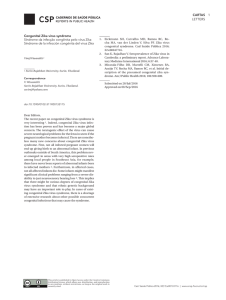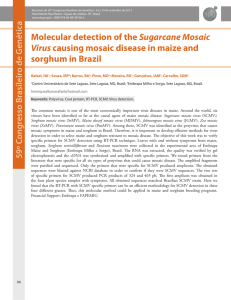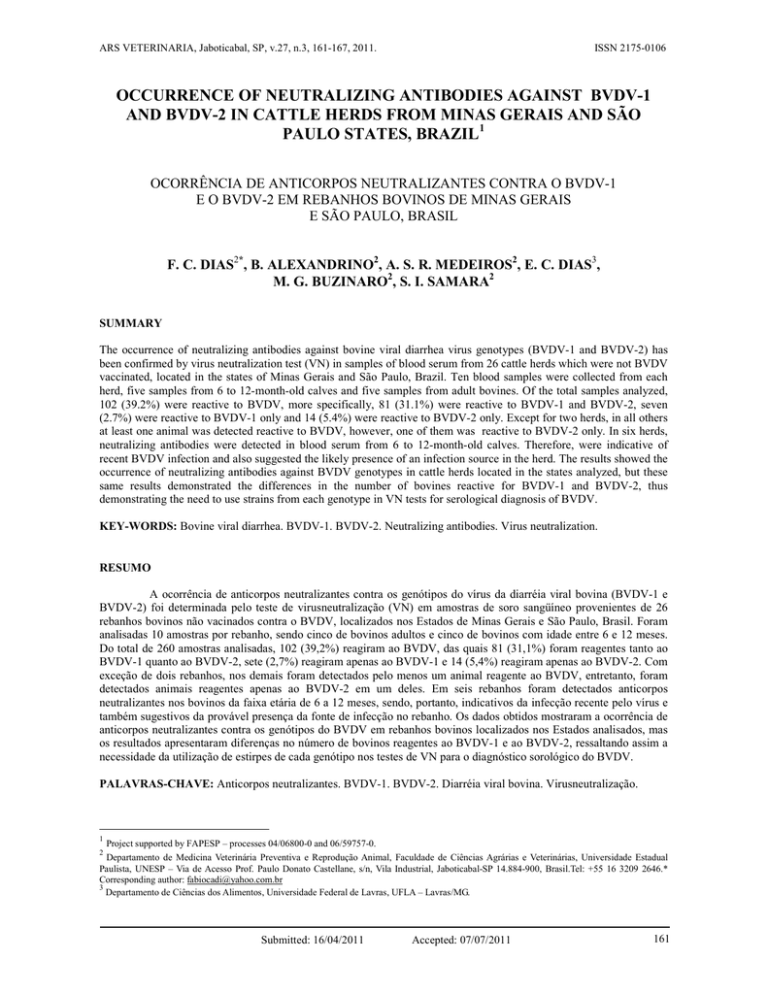
ARS VETERINARIA, Jaboticabal, SP, v.27, n.3, 161-167, 2011.
ISSN 2175-0106
OCCURRENCE OF NEUTRALIZING ANTIBODIES AGAINST BVDV-1
AND BVDV-2 IN CATTLE HERDS FROM MINAS GERAIS AND SÃO
PAULO STATES, BRAZIL1
OCORRÊNCIA DE ANTICORPOS NEUTRALIZANTES CONTRA O BVDV-1
E O BVDV-2 EM REBANHOS BOVINOS DE MINAS GERAIS
E SÃO PAULO, BRASIL
F. C. DIAS2*, B. ALEXANDRINO2, A. S. R. MEDEIROS2, E. C. DIAS3,
M. G. BUZINARO2, S. I. SAMARA2
SUMMARY
The occurrence of neutralizing antibodies against bovine viral diarrhea virus genotypes (BVDV-1 and BVDV-2) has
been confirmed by virus neutralization test (VN) in samples of blood serum from 26 cattle herds which were not BVDV
vaccinated, located in the states of Minas Gerais and São Paulo, Brazil. Ten blood samples were collected from each
herd, five samples from 6 to 12-month-old calves and five samples from adult bovines. Of the total samples analyzed,
102 (39.2%) were reactive to BVDV, more specifically, 81 (31.1%) were reactive to BVDV-1 and BVDV-2, seven
(2.7%) were reactive to BVDV-1 only and 14 (5.4%) were reactive to BVDV-2 only. Except for two herds, in all others
at least one animal was detected reactive to BVDV, however, one of them was reactive to BVDV-2 only. In six herds,
neutralizing antibodies were detected in blood serum from 6 to 12-month-old calves. Therefore, were indicative of
recent BVDV infection and also suggested the likely presence of an infection source in the herd. The results showed the
occurrence of neutralizing antibodies against BVDV genotypes in cattle herds located in the states analyzed, but these
same results demonstrated the differences in the number of bovines reactive for BVDV-1 and BVDV-2, thus
demonstrating the need to use strains from each genotype in VN tests for serological diagnosis of BVDV.
KEY-WORDS: Bovine viral diarrhea. BVDV-1. BVDV-2. Neutralizing antibodies. Virus neutralization.
RESUMO
A ocorrência de anticorpos neutralizantes contra os genótipos do vírus da diarréia viral bovina (BVDV-1 e
BVDV-2) foi determinada pelo teste de virusneutralização (VN) em amostras de soro sangüíneo provenientes de 26
rebanhos bovinos não vacinados contra o BVDV, localizados nos Estados de Minas Gerais e São Paulo, Brasil. Foram
analisadas 10 amostras por rebanho, sendo cinco de bovinos adultos e cinco de bovinos com idade entre 6 e 12 meses.
Do total de 260 amostras analisadas, 102 (39,2%) reagiram ao BVDV, das quais 81 (31,1%) foram reagentes tanto ao
BVDV-1 quanto ao BVDV-2, sete (2,7%) reagiram apenas ao BVDV-1 e 14 (5,4%) reagiram apenas ao BVDV-2. Com
exceção de dois rebanhos, nos demais foram detectados pelo menos um animal reagente ao BVDV, entretanto, foram
detectados animais reagentes apenas ao BVDV-2 em um deles. Em seis rebanhos foram detectados anticorpos
neutralizantes nos bovinos da faixa etária de 6 a 12 meses, sendo, portanto, indicativos da infecção recente pelo vírus e
também sugestivos da provável presença da fonte de infecção no rebanho. Os dados obtidos mostraram a ocorrência de
anticorpos neutralizantes contra os genótipos do BVDV em rebanhos bovinos localizados nos Estados analisados, mas
os resultados apresentaram diferenças no número de bovinos reagentes ao BVDV-1 e ao BVDV-2, ressaltando assim a
necessidade da utilização de estirpes de cada genótipo nos testes de VN para o diagnóstico sorológico do BVDV.
PALAVRAS-CHAVE: Anticorpos neutralizantes. BVDV-1. BVDV-2. Diarréia viral bovina. Virusneutralização.
1
Project supported by FAPESP – processes 04/06800-0 and 06/59757-0.
Departamento de Medicina Veterinária Preventiva e Reprodução Animal, Faculdade de Ciências Agrárias e Veterinárias, Universidade Estadual
Paulista, UNESP – Via de Acesso Prof. Paulo Donato Castellane, s/n, Vila Industrial, Jaboticabal-SP 14.884-900, Brasil.Tel: +55 16 3209 2646.*
Corresponding author: [email protected]
3
Departamento de Ciências dos Alimentos, Universidade Federal de Lavras, UFLA – Lavras/MG.
2
Submitted: 16/04/2011
Accepted: 07/07/2011
161
ARS VETERINARIA, Jaboticabal, SP, v.27, n.3, 161-167, 2011.
INTRODUCTION
The bovine viral diarrhea (BVD) consists of a
syndrome associated with clinical or asymptomatic
infection with bovine viral diarrhea virus (BVDV)
(BOLIN & RIDPATH, 1996). However, a significant
percentage of infections (70 to 90%) is asymptomatic
(BAKER, 1995). The disease is common in most
countries and BVDV is a pathogen of cattle,
particularly of the reproductive system (BROWNLIE,
2005).
The BVDV is an RNA virus that together with
classical swine fever virus (CSFV) and the border
disease virus (BDV) make up the genus Pestivirus, of
the family Flaviviridae (NETTLETON & ENTRICAN,
1995). The BVDV is classified in two different species
or genotypes BVDV-1 and BVDV-2, both of which
can exist as two biotypes, cytopathogenic (CP) and
non-cytopathogenic (NCP) (RIDPATH, 2010).
Theoretically, all cattle herds are infected or have
suffered the infection at a given time (NETTLETON
& ENTRICAN, 1995). BVD is widespread throughout
the world, between 50 and 90% of the adult cattle
herds has neutralizing antibodies against BVDV
(HOUE & MEYLING, 1991; HOUE, 1999; KRAMPS
et al., 1999). However, the occurrence of a recent
infection or transmission of BVDV in the herd can be
verified by detecting neutralizing antibodies in young
animals (SMITH & GROTELUESCHEN, 2004).
BVDV infection is widespread in Brazilian herds
and the virus strains isolated show remarkable
antigenic variability and the phylogenetic analysis
performed on these strains showed the presence of
BVDV-1 and BVDV-2 (OLIVEIRA et al., 1996;
CANAL et al., 1998; BOTTON et al., 1998; FLORES
et al., 2000).
However, most studies conducted in Brazil
researched only the antibodies against BVDV-1, which
might result in failure to detect antibodies against
BVDV-2 when they are present at low or moderate
levels (FLORES et al., 2005). Thus, the aim of this
study was to detect neutralizing antibodies against
BVDV-1 and BVDV-2 in cattle herds from farms in
Minas Gerais and São Paulo states, Brasil.
MATERIAL AND METHODS
Herds
During the period between January, 2005 and April,
2006, blood samples were drawn from 26 cattle herds
from Minas Gerais and São Paulo. In Minas Gerais, the
samples were collected from 6 herds located in the
following municipalities: Machado, Poço Fundo and
São Gonçalo do Sapucaí. In São Paulo, the samples
were collected from 20 herds located in the
municipalities of Jaboticabal, Monte Alto, Sertãozinho,
São Carlos, Guariba, Pedregulho, São José do Rio
Preto, Cristais Paulista, Buritizal and Rifaina.
These herds were not vaccinated against BVDV.
Dairy and beef cattle were used in the study, and herds
had between 20 and 480 animals. The herds were
randomly sampled, regardless of management,
162
ISSN 2175-0106
production system, number of animals, breed,
productivity and presence or not of reproductive
problems.
Sampling
The number of samples per herd was based on the
modified methodology adopted by Luzzago et al.
(1999). Ten blood samples were obtained randomly
from each herd, 5 from adult animals and 5 from
animals aged between 6 and 12 months, totaling 260
samples.
Blood samples were drawn and stored in siliconized
“vacutainer” BD® tubes, centrifuged at 1,080xg and
divided into two 1.5-mL-serum aliquots for testing
against BVDV-1 and BVDV-2. The serum aliquots
were distributed into “eppendorf” tubes, identified and
stored at -20ºC, until used. Blood serum samples were
split in order to guarantee identical handling conditions
before the serological tests against BVDV-1 and
BVDV-2 were conducted.
Virus neutralization test – VN
All samples underwent VN test for antibodies
against BVDV-1 and BVDV-2 (OIE, 2008). The VN
test used epithelial cells of bovine kidney of the
“Madin Darby bovine kidney” (MDBK) line, kept in
Eagle MEM (Minimal Essential Medium) Gibco®
medium, supplemented with 10% fetal bovine serum
(SFB) Cultilab® free of Pestivirus and antibodies
against BVDV, using the cytopathogenic strains (CP)
of BVDV-1 (Singer) and of BVDV-2 (VS-253). Before
testing, blood serum samples were previously
inactivated at 56ºC, for 30 minutes. The virus
neutralization tests were performed on disposable
microtiter plates of 96 wells TPP®. To the maintenance
medium Eagle-MEM Gibco® used for serum samples
dilution, a 1% penicillin solution
(10,000UI mL-1)
-1
and streptomycin (10,000ug mL ) Gibco® was added.
Each serum sample tested was duplicated by
successive dilutions between 1:10 and 1:5,120. After
adding the viral suspension containing 100 TCID50
(50% tissue culture infective doses) of BVDV, the
microplates were incubated in 5% CO2 atmosphere at
37ºC. After 60 minutes, it was added to each cell well,
a suspension of MDBK cells containing 300,000 cells
mL-1 in Eagle-MEM Gibco® maintenance medium with
10% SFB Cultilab®. Subsequently, the plate was again
incubated in an oven at 37ºC, in 5% CO2 atmosphere
for 96 hours. The serum samples that neutralized 100
TCID50 of BVDV in 1:10 dilution were considered
reactive. Samples reactive to 1:5,120 dilution were
retested in duplicate to the dilution 1:20,480. The
antibody titers were expressed as the reciprocal of the
highest dilution where it was detected virus
neutralization, and the final titer resulted from the
geometric mean of the titers found in duplicates.
RESULTS
Blood serum samples were analyzed of 260
nonvaccinated animals from cattle herds of Minas
Gerais and São Paulo, of which 102 (39.2%) were
reactive to BVDV.
ARS VETERINARIA, Jaboticabal, SP, v.27, n.3, 161-167, 2011.
ISSN 2175-0106
Table 1. Results of VN tests for BVDV-1 and BVDV-2 performed on blood serum samples of cattle not vaccinated
against BVDV from herds located in Minas Gerais and São Paulo States.
BVDV-1
Reactive
Non-reactive
Total
Reactive
81 (31.1%)
14 (5.4%)
95 (36.5%)
Non-reactive
7 (2.7%)
158 (60.8%)
165 (63.5%)
Total
88 (33.8%)
172 (66.2%)
260 (100%)
BVDV-2
Considering the age group analyzed, 73 (56.15%) of
130 samples from adult cattle and only 29 (23.3%) of
130 samples of animals between 6 and 12 months were
reactive to BVDV.
Of the 102 samples reactive to BVDV, 81 (31.1%)
were reactive to both BVDV-1 and BVDV-2, seven
(2.7%) were reactive to BVDV-1 only and 14 (5.4%)
were reactive to BVDV-2 only. A total of 88 (33.8%)
samples were reactive to BVDV-1 and 95 (36.5%) to
BVDV-2 (Table 1).
Regarding the VN tests for BVDV-1 and BVDV-2
performed in 60 blood serum samples from herds
located in Minas Gerais, 36 (60%) were reactive to
BVDV. Of these samples 30 (50%) were reactive to
both BVDV-1 and BVDV-2, none was reactive to
BVDV-1 only and six (10%) were reactive to BVDV-2
only. A total of 30 (40%) samples were reactive to
BVDV-1 and 36 (60%) to BVDV-2. The VN tests
performed for BVDV-1 and BVDV-2 in 200 serum
samples from herds located in São Paulo detected 66
(33%) reactive to BVDV. Of these samples, 51
(25.5%) were reactive to both BVDV-1 and BVDV-2,
seven (3.5%) were reactive to BVDV-1 and eight (4%)
were reactive to BVDV-2 only. A total of 58 (29%)
samples were reactive to BVDV-1 and 59 (29.5%)
were reactive to BVDV-2.
The distribution of reactive samples per herd,
variation of the respective mean antibody titer against
BVDV-1 and BVDV-2, as well as the results for
different age groups are shown in Table 2. From the
total of 26 herds tested, it was found at least one animal
reactive to BVDV-1 and to BVDV-2 in 23 and 24
herds, respectively. In the adult age group, animals
reactive to BVDV-1 were found in 23 herds and, to
BVDV-2, in 24 herds. For the calves, the 6 to 12 month
age group, ten herds had animals reactive to BVDV-1
and ten herds to BVDV-2. The total number (adults
and calves) of animals reactive to BVDV-1 per herd
varied between 1 and 9, while antibody titers ranged
from 10 to 2,560. For BVDV-2, the total number of
reactive animals varied between 1 and 8 while antibody
titers ranged from 10 to 3,620.
From the samples analyzed in this study, 39.2% of
the animals were reactive to BVDV. However, half of
the samples analyzed were from young animals aged
between 6 and 12 months. When analyzing only the
results of the VN tests of adult animals, the number of
reactive animals of this age group (56.15%) was in the
range proposed by Houe (1999), who considered that
between 50 and 90% of the adult cattle population has
antibodies against BVDV.
The results presented in this study are very similar
to other studies conducted in Brazil for adult animals
reactive to BVDV (PELLEGRIN et al., 1997; PITUCO
et al., 1998; GUIMARÃES et al., 2001; DIAS &
SAMARA, 2003; NORONHA et al., 2003; ALFAIA et
al., 2004).
In Brazil, the first serological survey for BVDV
was conducted by Wizigmann et. al (1972). According
to Flores et al. (2005), several studies were also
conducted in other Brazilian states, but from the
epidemiological point of view, the number of reactive
cattle detected should be interpreted with caution, since
some herds had reproductive problems and the
majority did not take into account that part of the
reactive samples could be the result of vaccination.
However, in this study the herds were not vaccinated
against BVDV and the herds were randomly chosen
independent of management, production system,
quantity of animals, breed, productivity and the
presence or not of reproductive problems.
The number of animals reactive to BVDV from the
cattle herds located in Minas Gerais was proportionally
greater than those from São Paulo. This difference
could be related to the fact that most of the herds
analyzed in Minas Gerais were more densely populated
and consequently, the more intensive management
facilitated the spreading of the virus (HOUE &
MEYLING, 1991; HOUE, 1995; HOUE, 1999;
MOCKELIUNIENE et al., 2004; SMITH &
GROTELUESCHEN, 2004).
The results of the VN tests of the 102 samples
reactive to BVDV, for both virus genotypes showed
that 81 (31.1%) were reactive to both BVDV-1 and
BVDV-2, while seven (2.7%) and 14 (5.4%) were
DISCUSSION
163
ARS VETERINARIA, Jaboticabal, SP, v.27, n.3, 161-167, 2011.
ISSN 2175-0106
Table 2. Number of reactive animals according to age bracket and variation of antibody titers in the VN tests against BVDV-1 and BVDV-2, from herds located in Minas Gerais and São
Paulo States.
Herd
164
BVDV-1
Adults
Calves
Reactive
Variation of antibody
Reactive
Variation of
animals/sample
titers
animals/sample
antibody titers
4/5
80 a 2.560
4/5
80 a 160
BVDV-2
Adults
Calves
Reactive animals/
Variation of
Reactive
Variation of
sample
antibody titers
animals/ sample
antibody titers
4/5
160 a 3.620
4/5
20 a 160
City
State
1
Machado
MG
2
S. G. do Sapucaí
MG
3/5
160 a 640
4/5
40 a 320
3/5
20 a 640
5/5
40 a 3.620
3
S. G. do Sapucaí
MG
1/5
20
0/5
0
1/5
453
1/5
14
4
Poço Fundo
MG
2/5
20 a 2.560
3/5
640 a 1.280
2/5
160 a 2.560
5/5
160 a 2.560
5
Poço Fundo
MG
4/5
10 a 320
1/5
20
5/5
20 a 1.810
2/5
20 a 40
6
Machado
MG
4/5
80 a 2.560
0/5
0
4/5
14 a 640
0/5
0
7
S. J. do Rio Preto
SP
2/5
10 a 320
1/5
10
4/5
10 a 120
0/5
0
8
Jaboticabal
SP
0/5
0
0/5
0
0/5
0
0/5
0
9
Sertãozinho
SP
1/5
1.280
0/5
0
1/5
320
0/5
0
10
São Carlos
SP
2/5
10 a 20
0/5
0
3/5
10 a 80
0/5
0
11
São Carlos
SP
0/5
0
0/5
0
0/5
0
0/5
0
12
Jaboticabal
SP
2/5
40 a 80
0/5
0
1/5
10
0/5
0
13
Jaboticabal
SP
2/5
10 a 20
0/5
0
2/5
10 a 20
0/5
0
14
Guariba
SP
3/5
160
0/5
0
3/5
80 a 160
0/5
0
15
Guariba
SP
2/5
80 a 640
0/5
0
2/5
20 a 240
0/5
0
16
Guariba
SP
4/5
40 a 2.560
1/5
10
3/5
80 a 905
0/5
0
17
Pedregulho
SP
5/5
80 a 320
4/5
10 a 1.280
5/5
56 a 120
3/5
10 a 80
18
Pedregulho
SP
1/5
20
0/5
0
1/5
40
0/5
0
19
Cristais Paulista
SP
2/5
320
0/5
0
2/5
160 a 196
0/5
0
20
Buritizal
SP
5/5
226 a 905
1/5
640
5/5
10 a 905
2/5
40 a 905
21
Pedregulho
SP
4/5
80 a 320
2/5
10 a 320
4/5
28 a 80
1/5
40
22
Buritizal
SP
2/5
40 a 320
0/5
0
2/5
80 a 226
1/5
10
23
Buritizal
SP
3/5
40 a 80
0/5
0
3/5
452
0/5
0
24
Cristais Paulista
SP
0/5
0
0/5
0
2/5
10 a 20
0/5
0
25
Monte Alto
SP
4/5
10 a 640
0/5
0
4/5
10 a 320
0/5
0
26
Rifaina
SP
4/5
40 a 1.280
1/5
10
4/5
10 a 320
1/5
28
ARS VETERINARIA, Jaboticabal, SP, v.27, n.3, 161-167, 2011.
reactive only to BVDV-1 and BVDV-2, respectively.
Similar results were found in the study by Flores et al.
(2000), who reported 2.5% of samples reactive to
BVDV-1 only and 3.3% to BVDV-2. A total of 88
(33.8%) were reactive to BVDV-1 and 95 (36.5%) to
BVDV-2.
These results showed that the use of only one
genotype strain in the VN tests resulted in falsenegative diagnosis for the other genotype according to
the observations made by Flores et al. (2000), Fulton et
al. (2000), Fulton et al. (2002), Chase et al. (2003) and
Flores et al. (2005).
The use of BVDV-2 strains in the VN test would
also be required in the case of herd individual analysis,
since herd 24 from São Paulo (Table 2), would be
diagnosed as false-negative because it had only two
animals reactive to BVDV-2 and none reactive to
BVDV-1. Another aspect to be reported is the higher
antibody levels of VN tests (3,620) found in animals
reactive to BVDV-2, specifically in herds 1 and 2
(Table 2).
All herds from Minas Gerais had at least one
animal reactive to BVDV. In São Paulo, with the
exception of herds 8 and 11 (Table 2), every other herd
had at least one reactive animal, the same was reported
by Richtzeinhain et al. (1999) and Dias & Samara
(2003), which shows that at some point, these herds
have
experienced
infection
with
BVDV
(NETTLETON & ENTRICAN, 1995).
The number of reactive adult animals was greater
than the number of young animals infected. According
to Mockliuniene et al. (2004), the number of reactive
animals increases with age, thus suggesting the
occurrence of old infections, after all the titers of
antibodies against BVDV are long lasting after natural
infection (LINDBERG & HOUE, 2005) and they
decrease only a few years after the occurrence of
infection (FREDRIKSEN et al., 1999).
Many of the cattle herds analyzed had high titers of
antibodies, but this is not enough to predict the
presence of BVDV in the herd. The fact that BVDV
antibodies are long lasting after natural infection
occurs, poses a challenge when trying to detect the true
infection stage of the herd (HOUE, 1999; LINDBERG
& HOUE, 2005).
In some of the cattle herds with reactive animals
and high antibody titers, a number of the animals were
between 6 and 12 months. This was seen in herds 1, 2,
4, 17, 20 and 21 (Table 2). In this case, the detection of
neutralizing antibodies in this age bracket, as well as
the high titers indicated recent infection by BVDV and
the likely presence of a source of infection in the herd
(SMITH & GROTELUESCHEN, 2004).
The pathogenesis of BVDV infections has peculiar
characteristics, which is reflected in the epidemiology
and is not observed in other diseases. In
epidemiological studies of BVDV, the main challenges
are to detect the stage of infection, the way the BVDV
is spreading within the herd and the source of infection
and finally, the challenge of quantifying the economic
losses (HOUE, 2003; SMITH & GROTELUESCHEN,
2004).
ISSN 2175-0106
CONCLUSIONS
The results confirm the occurrence of cattle with
neutralizing antibodies against BVDV-1 and BVDV-2
in cattle herds from Minas Gerais and São Paulo, and
in most analyzed herds it was found at least one
reactive animal. The use of only one genotype strain of
BVDV in VN tests resulted in false-negative diagnosis
for the other genotype, which indicated the need to use
strains of each genotype in the VN test to diagnose
BVDV accurately. The neutralizing antibodies detected
in young animals suggested the presence of BVDV in
some of the analyzed herds.
ACKNOWLEDGMENTS
The authors are thankful to Fundação de Apoio e
Pesquisa do Estado de São Paulo (FAPESP), for the
financial support (Processes 04/06800-0 and 06/597570) and to Prof. Dr. Eduardo Furtado Flores, from
Universidade Federal de Santa Maria, who kindly
supplied the cytopathogenic strains of
BVDV-1
(Singer) and BVDV-2 (VS-253) to perform the VN
tests.
REFERENCES
ALFAIA, B. T.; BARBOSA, A. C. V. C.; CAIXETA,
S. P. M. B.; ROCHA, W. V.; BRITO, W. M. E. D.
Prevalence and risk factors associated with BVDV
infection in adult and non-vaccinated bovines females
from Goiás State, Brazil. Virus Reviews and
Research, v.9, n.1, p.127, 2004.
BAKER, J. C. The clinical manifestations of bovine
viral diarrhea infection. Veterinary Clinics of North
America: Food Animal Practice, v.11, n.3, p.425445, 1995.
BOLIN, S. R.; RIDPATH, J. F. The clinical
significance of genetic variation among bovine viral
diarrhea viruses. Veterinary Medicine, v.91, n.10,
p.958-961, 1996.
BOTTON, S. A.; SILVA, A. M.; BRUM, M. C. S.;
WEIBLEN, R.; FLORES, E. F. Antigenic
characterization of Brazilian bovine viral diarrhea virus
isolates by monoclonal antibodies and crossneutralization. Brazilian Journal of Medical and
Biological Research, v.31, n.11, p.1.429-1.438, 1998.
BROWNLIE, J. Bovine virus diarrhoea virus. In:
BVDV SYMPOSIUM, 2005, Wellington. Anais…
Wellington, 2005, p.1-19.
CANAL, C. W.; STRASSER, M.; HERTIG, C.;
MASUDA, A.; PETERHANS, E. Detection of
antibodies to bovine viral diarrhea virus (BVDV) and
characterization of genomes of BVDV from Brazil.
Veterinary Microbiology, v.63, n.2-4, p.85-97, 1998.
165
CHASE, C. C. L.; CHASE, S. K.; FAWCETT, L.
Trends in the BVDV serological response in the Upper
Midwest. Biologicals, v.31, n.2, p.145-151, 2003.
DIAS, F. C.; SAMARA, S. I. Detecção de anticorpos
contra o vírus da diarréia viral bovina no soro
sangüíneo, no leite individual e no leite de conjunto em
tanque de expansão de rebanhos não vacinados.
Brazilian Journal of Veterinary Research and
Animal Science, v.40, n.3, p.161-168, 2003.
FLORES, E. F.; WEIBLEN, R.; GIL, L. H. V. G.;
TOBIAS, F. L.; LIMA, M.; GARCEZ, D. C.;
BOTTON, S. A. Diversidade antigênica de amostras do
vírus da diarréia viral bovina isoladas no Brasil:
implicações para o diagnóstico e estratégias de
imunização. Arquivo Brasileiro de Medicina
Veterinária e Zootecnia, v.52, n.1, p.11-17, 2000.
FLORES, E. F.; WEIBLEN, R.; VOGEL, F. S. F.;
ROEHE, P. M.; ALFIERI, A. A.; PITUCO, E. M. A
infecção pelo vírus da diarréia viral bovina (BVDV) no
Brasil – histórico, situação atual e perspectivas.
Pesquisa Veterinária Brasileira, v.25, n.3, p.125-134,
2005.
FREDRIKSEN, B.; SANDVIK, T.; LOKEN, T.;
ODEGAARD, S. A. Level and duration of serum
antibodies in cattle infected experimentally and
naturally with bovine virus diarrhea virus. The
Veterinary Record, v.144, n.5, p.111-114, 1999.
FULTON, R. W.; RIDPATH, J. F.; SALIKI, J. T.;
BRIGGS, R. E.; CONFER, A. W.; BURGE, L. J.,
PURDY, C. W.; LOAN, R. W.; DUFF, G. C.;
PAYTON, M. E. Bovine viral diarrhea virus (BVDV)
1b: predominant BVDV subtype in calves with
respiratory disease. Canadian Journal of Veterinary
Research, v.66, n.3, p.181-190, 2002.
FULTON, R. W.; SALIKI, J. T.; CONFER, A. W.;
BURGE, L. J.; d’OFFAY, J. M.; HELMAN, R. G.;
BOLIN, S. R.; RIDPATH, J. F.; PAYTON, M. E.
Bovine viral diarrhea virus cytophatic and
noncytophatic biotypes and type 1 and 2 genotypes in
diagnostic laboratory accessions: clinical and necropsy
samples from cattle. Journal of Veterinary
Diagnostic Investigation, v.12, n.1, p.33-38, 2000.
HOUE, H. Economic impact of BVDV infection in
dairies. Biologicals, v.31, n.2, p.137-143, 2003.
HOUE, H.; MEYLING, A. Prevalence of bovine virus
diarrhea (BVD) in 19 Danish dairy herds and
estimation of incidence of infection in early pregnancy.
Preventive Veterinary Medicine, v.11, n.1, p.9-16,
1991.
KRAMPS, J. A.; MAANEN, C. V.; WETERING, G.
V.; STIENSTRA, G.; QUAK, S.; BRINKHOF, J.;
RONSHOLT, L.; NYLIN, B. A simple, rapid and
reliable enzyme-linked immunosorbent assay for the
detection of bovine virus diarrhea virus (BVDV)
specific antibodies in cattle serum, plasma and bulk
milk. Veterinary Microbiology, v.64, n.2-3, p.135144, 1999.
LINDBERG, A.; HOUE, H. Characteristics in the
epidemiology of bovine viral diarrhea virus (BVDV) of
relevance control. Preventive Veterinary Medicine,
v.72, n.1-2, p.55-73, 2005.
LUZZAGO, C.; PICCININI, R.; ZEPPONI, A.;
ZECCONI, A. Study on prevalence of bovine viral
diarrhea virus (BVDV) antibodies in 29 Italian dairy
herds with reproductive problems. Veterinary
Microbiology, v.64, n.2-3, p.247-252, 1999.
MOCKELIUNIENE,
V.;
SALOMSKAS,
A.;
MOCCKELIUNAS, R.; PETKEVICIUS, S. Prevalence
and epidemiological features of bovine viral diarrhea
Veterinary
virus
infection
in
Lithuania.
Microbiology, v.99, n.1, p.51-57, 2004.
NETTLETON, P. F.; ENTRICAN, G. Ruminant
pestiviruses-review. British Veterinary Journal,
v.151, n.6, p.615-642, 1995.
NORONHA, R. P.; CAMPOS, G. S.; SARDI, S. I.
Pesquisa do vírus da diarréia viral bovina em bovinos
jovens. Brazilian Journal of Veterinary Research
and Animal Science, v.40, n.6, p.424-430, 2003.
OIE. Office International des Épizooties. Manual of
standards for diagnostic tests and vaccines, Paris.
Available
in:
<http://www.oie.int/eng/normes/mm
anual/A_00132.htm. Access on: 30/08/08.
GUIMARÃES, P. L. S. N.; CHAVES, N. S. T.;
SILVA, L. A. F.; ACYPRESTE, C. S. Freqüência de
anticorpos contra o vírus da diarréia viral bovina em
bovinos, em regime de criação semi-extensivo. Ciência
Animal Brasileira, v.2, n.1, p.35-40, 2001.
OLIVEIRA, L. G.; OLIVEIRA, E. A. S.; SILVA, L. H.
T. Presença de Pestivirus e anticorpos contra Pestivirus
em soros e cultivos celulares. Arquivo Brasileiro de
Medicina Veterinária e Zootecnia, v.48, n.5, p.513521, 1996.
HOUE, H. Epidemiology of bovine viral diarrhea
virus. Veterinary Clinics of North America: Food
Animal Practice, v.11, n.3, p.521-547, 1995.
PELLEGRIN, A. O.; SERENO, J. R. B.; LEITE, R. C.
Seropositivity to bovine viral diarrhea virus (BVDV)
and bovine herpesvirus type 1 (BHV-1) in zebu cows
in the Brazilian Pantanal. Arquivo Brasileiro de
Medicina Veterinária e Zootecnia, Belo Horizonte,
v.49, n.3, p.375-377, 1997.
PITUCO, E. M.; DEL FAVA, C. Situação do BVDV
na
América
do
Sul.
In:
SIMPÓSIO
HOUE, H. Epidemiological features and economical
importance of bovine virus diarrhea virus (BVDV)
infections. Veterinary Microbiology, v.64, n.2-3,
p.89-107, 1999.
166
INTERNACIONAL
SOBRE
HERPESVÍRUS
BOVINO E VÍRUS DA DIARRÉIA VIRAL
BOVINA, 1998, Santa Maria. Anais ... Santa Maria,
1998, p.49-57.
RICHTZEINHAIN, L. J.; BARBARINI, O.;
UMEHARA, O.; De GRACIA, A. S.; CORTEZ, A.;
HEINEMANN, M. B.; FERREIRA, F.; SOARES, R.
M. Diarréia viral bovina: levantamento sorológico nos
Estados de Minas Gerais, Mato Grosso do Sul, São
Paulo, Rio de Janeiro, Paraná e Rio Grande do Sul.
Arquivos do Instituto Biológico, v.66, n.1, p.107-111,
1999.
RIDPATH, J. F. Bovine Viral Diarrhea Virus: Global
Status. 26:105-121. Veterinary Clinics of North
America: Food Animal Practice, v.26, p.105-121,
2010.
SMITH D. V.; GROTELUESCHEN D. M. Biosecurity
and biocontainment of bovine viral diarrhea virus.
Veterinary Clinics of North America – Food Animal
Practice, v.20, n.1, p.131-149, 2004.
WIZIGMANN, G., VIDOR, T., RICCI, Z. M. T.
Investigações sorológicas sobre a ocorrência e
incidência dos vírus da diarréia a vírus – Enfermidade
das mucosas dos bovinos, no Estado do Rio Grande do
Sul. Boletim do IPVDF, v.1, p.52-58, 1972.
167




